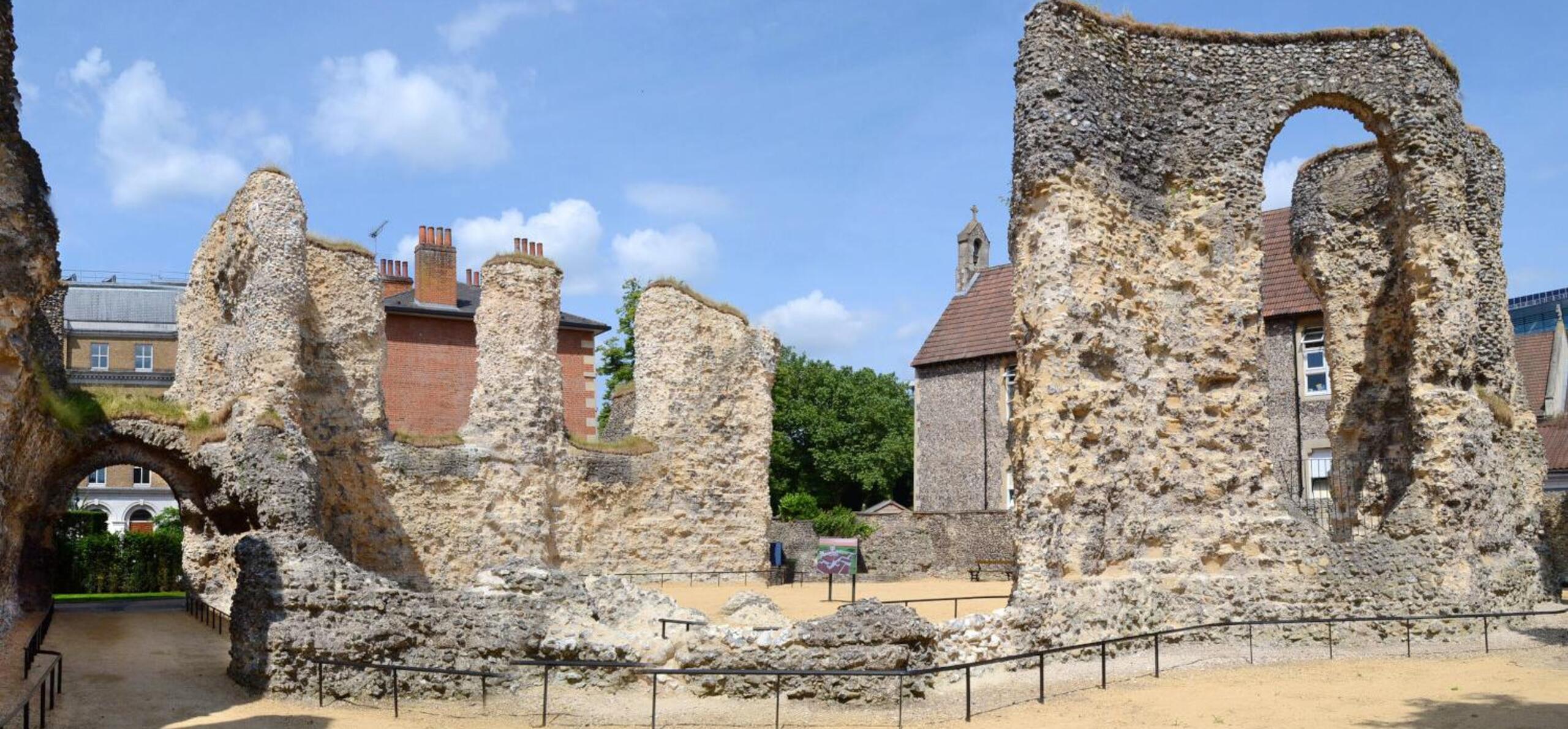Written by Anne Lawrence-Mathers, Professor of Medieval History, Reading, and Dr Helen Deeming, Lecturer in Music, Royal Holloway, University of London.
It is almost universally acknowledged that Harley 978 is most famous for the presence of the round or canon, 'Sumer is icumen in', the Summer song. This is celebrated in a plaque proudly displayed in the abbey ruins:
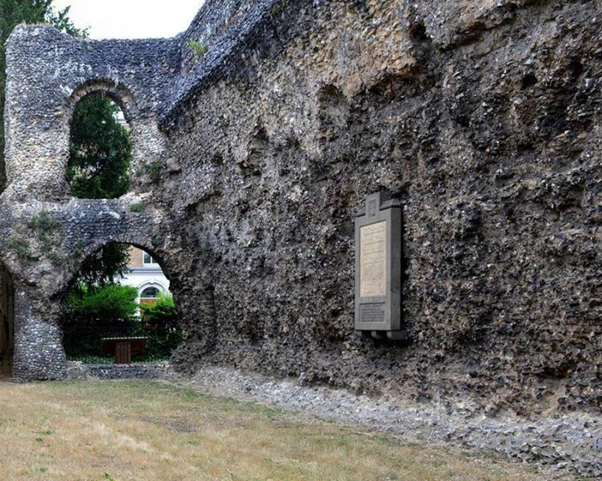
The chapter house of the Reading Abbey ruins bears a plaque depicting the iconic composition.
As can be seen in the image below, the plaque features the words and music of the song, as set out on folio 11v. of the Reading Abbey manuscript.
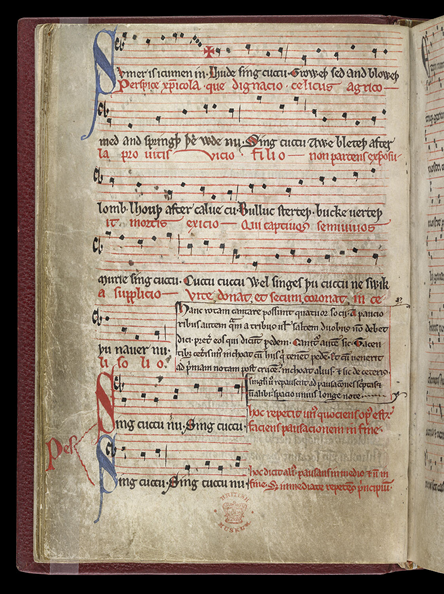
This folio is noticeably darker than others featured in this exhibition, and is rubbed on the outer edge. This is the result of the fame of the song, which caused the manuscript to be consulted by scholars of music and to be on display in the British Library for many years, open at this folio. The manuscript is no longer on display and has been digitised so that it can be seen on the Library’s website.
This musical piece is unusual – but not unique – in being provided with two alternative texts in different languages. The ‘red letter’ version is in Latin and expresses the singer’s devotion to Christ. The much more famous English words are in the everyday colour of black – but are placed above the religious words and have some red highlights as well as three large S initials. This suggests that the two versions perhaps have equal status on the page. But closer examination of the manuscript shows that the Latin words were composed later. The ‘Summer’ song is set out in full, with the words ‘Sing cuckoo’ as the ‘pes’ (accompanying ground or ostinato) – but no Latin words are given to be sung in the same way. This is odd, since the instructions for singing the song as a round, with the pes, are given in Latin (in the box in the lower part of the folio). Another piece of evidence is that some of the musical notes have been altered, among them the ones in the middle of the song that originally echoed the call of the cuckoo. This revision might suggest that the notes were composed for the English words but later altered for the Latin words.
The Summer song is part of a collection of musical pieces which makes up the first part of the manuscript, suggesting that it was important to the person who collected the contents and put the manuscript together. Possible evidence about this person is the fact that the collection includes a diagram, some exercises and a didactic song to be used by a teacher of music and singing.
Folio 14
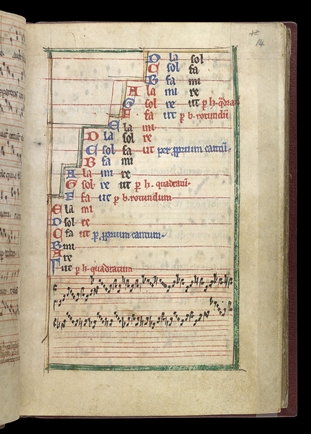
In this folio, a version of the ‘do re mi fa so la’ system for naming notes in a scale can be seen. It can be traced back to the influential, eleventh-century musical theorist, Guido of Arezzo, and was the standard method for teaching the basics of music for much of the Middle Ages.
The teaching material, plus the striking diversity and complexity among the songs collected here, suggest that this person was trained in music and hoped or expected to teach it. Since the musical teaching materials continue into the next section of the manuscript, which contains the calendar with Reading entries, it seems likely that this person expected to use his collection at Reading Abbey. He was clearly educated and may have been a monk with a role in the training of singers at the abbey.
Most of his musical collection was of a type directly suitable for teaching and performance at Reading. Aside from the music teaching materials there are ten compositions here which display both words and music (including the Summer song). One of these – like the Summer song – offers two alternative texts in different languages. Six of the total are addressed to, or in praise of, the Virgin Mary, who was the main saint to whom the abbey was dedicated (the other being St John the Evangelist). One is for the Apostles, one for St Thomas (Becket) and one relates the Biblical story of Samson. Three further musical pieces have no words, and there are a prayer to the Virgin and a poem for the Apostles which have no music. This variety, together with the expansion of the collection into the next portion of the manuscript, suggest that it may have been still a work in progress when its owner arrived at Reading.
Folios 8v to 9r
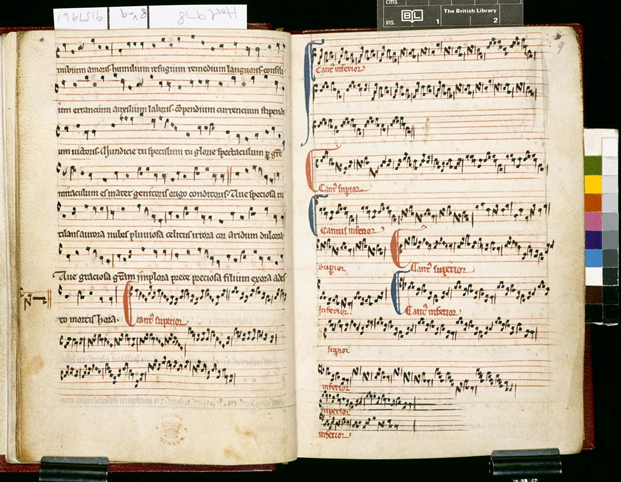
This opening of the manuscript first shows the end of one of the songs in praise of the Virgin, ‘Ave gloriosa virginum’. This ends towards the bottom of the page and a new composition starts at the point marked in red ‘cantus superior’. This is the beginning of the pieces of music without words, which have two parts and are presumably to be performed on instruments rather than sung. The ending of these pieces is squeezed into the bottom margin of folio 9r in a way which adds to the idea that this is work in progress rather the polished composition which the size of the folio might suggest.
In contrast, a composition which perhaps deserves to be better known is the celebratory piece for St Thomas, the martyred archbishop of Canterbury who was killed in his own cathedral in December 1170. This attractive song is monophonic rather than polyphonic, and is likely to have been written for the celebrations in 1220 which commemorated the fiftieth anniversary of the martyrdom. Its inclusion in this collection is interesting since it fits with the support for Becket found elsewhere in Harley 978.
Folio 13r
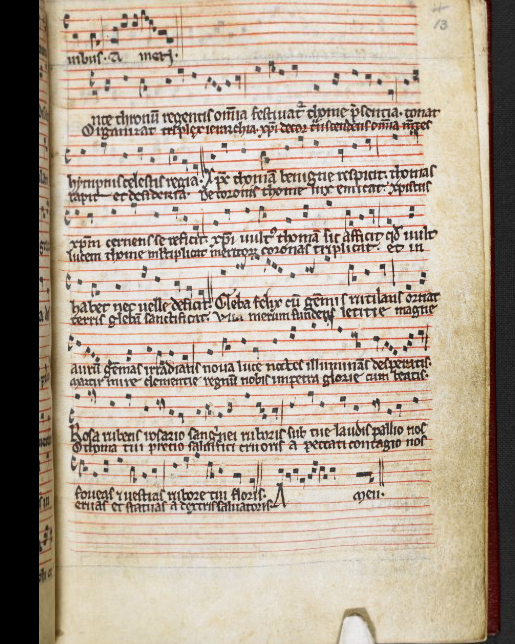
Folio 13r.
A treatise in Latin on the saint’s parents appears on folios 114v. to 116, with a partial French translation, suggesting an expectation of telling the story to laypeople who were interested in the saint. There are also two laments on the martyr’s death included amongst the collections of poems. Becket had actually consecrated the abbey church at Reading in 1164, not long before his famous defiance of Henry II and subsequent exile, so it is perhaps not surprising that the abbey had acquired an impressive collection of his relics by the end of the twelfth century. It is likely that Reading would have celebrated the ‘jubilee’ in 1220, but what music was performed is not recorded, so we cannot know the source of the composition in this manuscript. Nevertheless, it is clear that the musical section of this manuscript provided much that would have been valued in the abbey.
